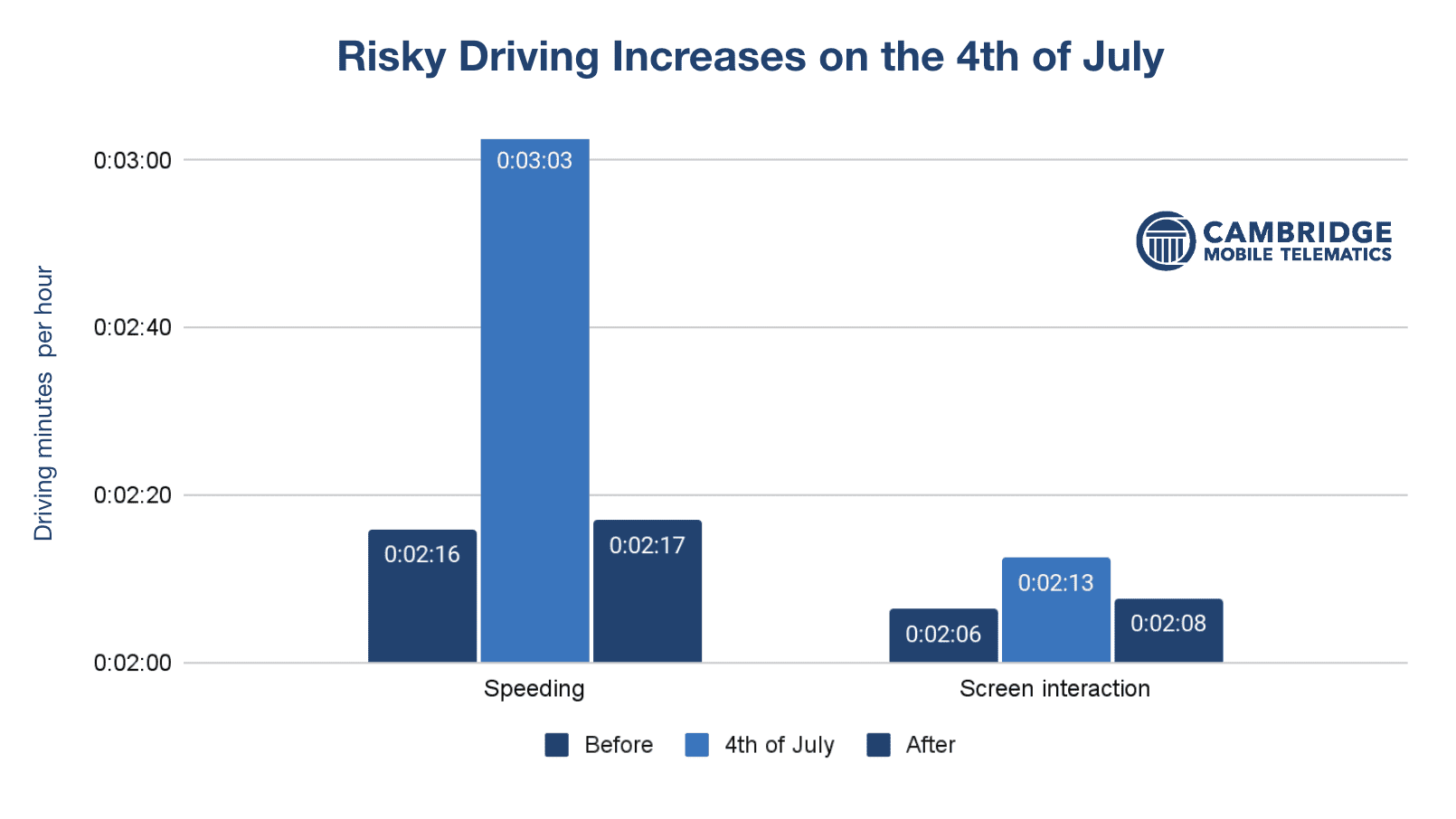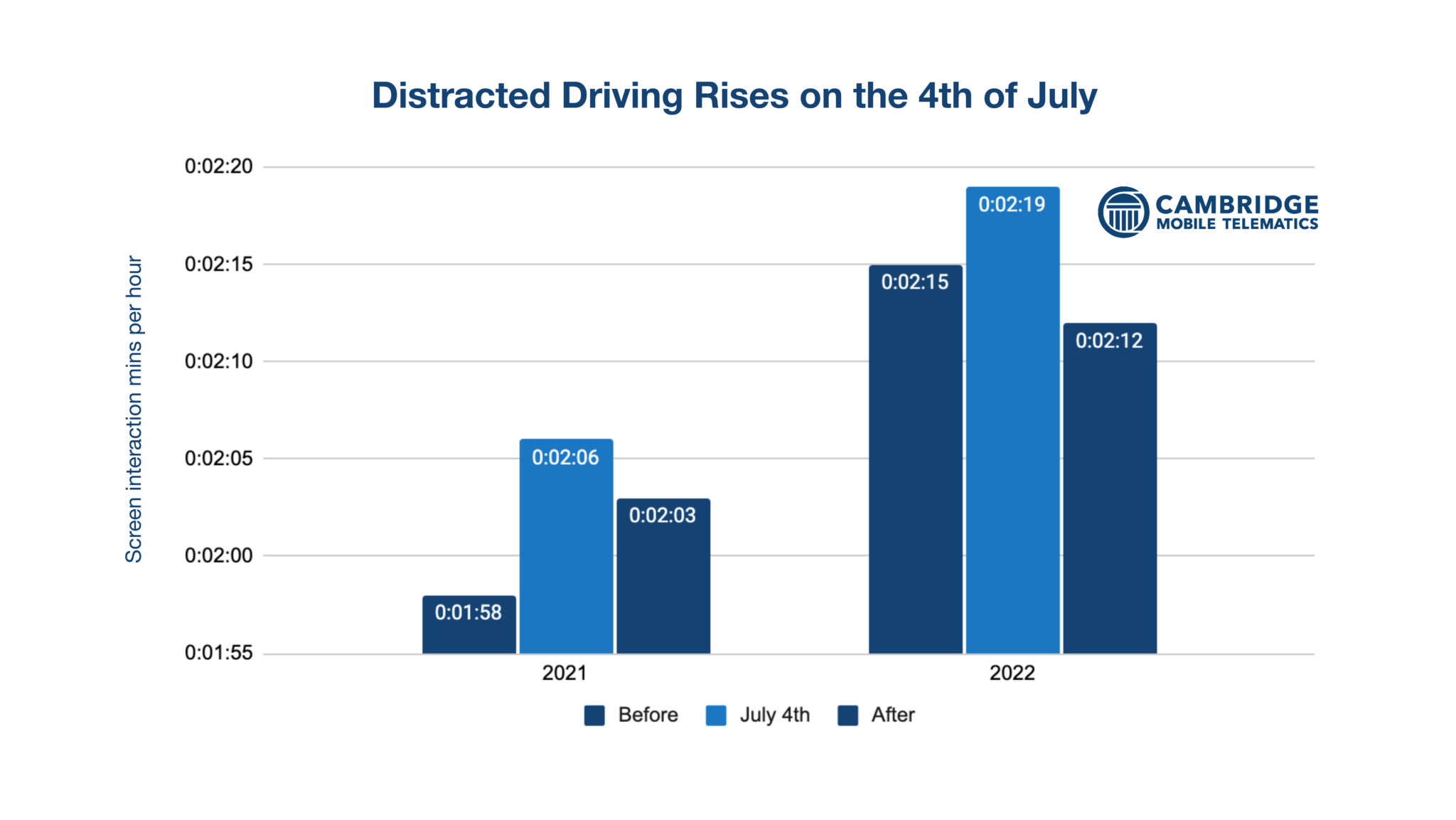New analysis: Dangerous driving behaviors increase on the Fourth of July

This year’s July 4th weekend is expected to break the record for the number of Americans traveling by car. According to AAA, 50.7 million Americans will travel 50 miles or more this Fourth of July weekend.
It’s a dangerous time for driving. NHTSA reports that there were 1,460 drivers killed on US roadways on the 4th of July from 2017 through 2021.
CMT has the ability to analyze the driving behaviors that lead to deadly crashes. We’ve found that dangerous driving behaviors skyrocket on the 4th of July.
We analyzed the 30 days before and after Independence Day for screen interaction and speeding from 2021 to 2022. Both driving risks increase dramatically on the 4th of July.
A 34% increase in time spent speeding
On the average day — 30 days before and after the 4th of July — US drivers spend 2 minutes and 17 seconds speeding every hour they’re on the road. On July 4th, that number jumps to 3 minutes and 3 seconds, 47 seconds more, a 34.6% increase.
The impact of more time spent speeding is more severe crashes. Speeding and distracted driving surged during the early days of the pandemic. Time spent speeding rose by 60%, while distraction increased by 18%. While there were fewer people driving during the pandemic, the increase in speeding and distraction contributed to the highest road fatality rate in 16 years.
“When we introduce holidays and the goal of getting someplace else in the shortest amount of time, we also incorporate speeding into the mix. We also tend to be more relaxed anticipating our holiday,” said Risk International Managing Director Phillip Renaud, who also chaired the Ohio Distracted Driving Road Safety Council.
“Coupling distraction and speeding is a fatal combination,” Renaud said.

In both 2021 and 2022, speeding on the 4th of July was significantly higher than on the days around it. In 2021, time spent speeding increased by 44 seconds, rising from 2 minutes and 12 seconds to 2 minutes and 55 seconds. 2022 saw an even steeper increase, jumping 50 seconds. Total time spent speeding on July 4th also accelerated in 2022, moving from 2 minutes and 55 seconds in 2021 to 3 minutes and 11 seconds in 2022.
Screen interaction increases by over 4%
The time drivers spend interacting with their phones while driving, which can be anything from texting to emailing, scrolling on social media, changing a song, playing a game, to taking a video call, increases by 4.2% on July 4th. The average summer day sees 2 minutes and 7 seconds. The 4th of July sees 2 minutes and 13 seconds.
This increase in distracted driving has deadly consequences. Thirty-four percent of drivers are distracted in the minute before they crash. Drivers who crash are two times more likely to use their phones the minute before a crash. Distraction also increases the crash rate — a CMT analysis found that for every 10% increase in distracted driving, the crash rate increases by 1.4%. We estimate that the 4.2% increase in distracted driving on July 4th results in over 230 additional crashes, 1 fatality, and $5.5 million in economic damages.*

Like speeding, screen interaction follows a similar pattern, with higher numbers each year. In 2021, drivers spent 2 minutes and 6 seconds interacting with their phones on July 4th, a 5-second increase. In 2022, that number reached 2 minutes and 19 seconds.
Not a seasonal trend
The increase in speeding and screen interaction on July 4th isn’t part of a seasonal trend. The average time spent speeding in the 30 days before July 4th is 2 minutes and 16 seconds. Afterward, it’s 2 minutes and 17 seconds.
For screen interaction, it’s 2 minutes and 6 seconds before and 2 minutes and 8 seconds after.
Overall, summer driving, which includes the 100 Deadliest Days of Summer, has increased levels of speeding and distraction. However, this elevated level of risky behaviors doesn’t impact the additional surge we see on July 4th — this risk is directly connected to July 4th driving.
Celebrate safely
CMT’s data shows that when drivers are aware of their behaviors, they drive safer. Drivers who frequently get driving feedback from a telematics app are 65% safer and 57% less distracted. These drivers also improve their driving over time, reducing distracted driving by 20% in 2 months.
Even if you don’t have a telematics app, you can pay attention to your driving safety. Remember to slow down, stay focused, and don’t use your phone while driving. Let’s make this Fourth of July a celebration of safety and responsible driving.
*Estimates based on the change in crash rate from distracted driving and data from NHTSA’s report The Economic and Societal Impact of Motor Vehicle Crashes, 2019: $340 billion in crash damages from 14.2 million crashes in 2019, averaging $23,954 per crash